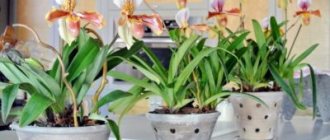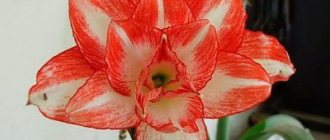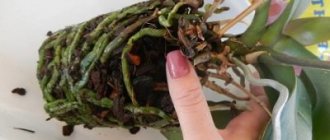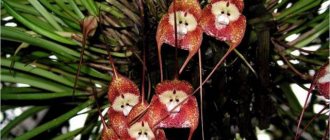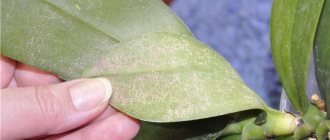How long does an orchid bloom at home?
It's no secret that orchids are grown specifically for their flowers. Large, of different colors, they stand out among the flowers of other plants with their unusual shape, reminiscent more of some fancy insects than, in fact, parts of plants. And the answer is simple: many Orchid species in nature attract male insects with the shape of their flowers , who mistake them for females and try to mate. Flying from flower to flower, the “deceived” males carry pollen. Let's look at how long orchids can bloom, why unopened buds fall off, and what to do about it.
How does the peduncle appear?
An orchid peduncle is a shoot that differs from the root shoot by its pointed end and scaly covering. The peduncle appears from the leaf axil and grows in any direction, curving bizarrely.
From a growing point and a waiting bud
Sometimes there are deviations in the growth of the peduncle and it can develop from a growing point, and during repeated flowering, from a waiting bud located on the previous flower shoot. In this case, there is no need to panic, just be more attentive to the changed conditions. During this period, the orchid is most sensitive to various stresses.
If the peduncle appears from the growing point, then usually after flowering the plant will produce a baby, which will already bloom in the usual way, releasing an arrow from the leaf axil.
If a new peduncle appears on the peduncle, it means that the old flower arrow has not yet dried out and continues to live. This phenomenon occurs when the orchid finishes flowering in the spring. When a new peduncle appears, a small number of buds are formed on the old one, and its growth is observed to the side of the main stem.
In this case, the plant needs to be given more light, increased humidity and fed with special fertilizers for orchids. If the phalaenopsis looks weakened, then the peduncle should be cut off after the first flowering.
Photo
The photo shows options for the appearance of the peduncle:
From the leaf axil
From the point of growth
From a waiting bud
Orchid blooms: how often, how to achieve rapid growth
The flowering period of Orchids begins with the growth of a long peduncle . Even in phalaenopsis with a short stem, the peduncle shoot can reach several decimeters and even a meter. An orchid can expel a peduncle for a long time, up to two months.
Has the orchid bloomed? If after the first flowering you do not cut off the peduncle, then next year a side shoot will grow from it, on which there will be a flower. A side shoot forms 2-3 times faster than a new peduncle.
The cycle of flowering and dormancy: what conditions are needed for home phalaenopsis
An orchid can bloom at any time of the year , as long as there is enough light, moisture and minerals. Moreover, some types of orchids can bloom for up to three months, and some gardeners claim that they managed to achieve flowering for 5 and even 8 months for orchids of the genus Phalaenopsis .
Creating the right microclimate is the basis for proper flowering
How long is the rest period in other species, reasons for less water consumption
Other orchids have different types of dormant periods:
| Conditional period of rest. Observed in Cattleya orchids | During this period, the home orchid begins to consume significantly less water , which is why it needs to be watered two to three times less often than during the growth period. It is advisable to stop feeding altogether. Observed after pseudobulb ripening and after flowering. |
| A dry dormant period is observed in Dendrobium King | During this period, it is necessary to abandon frequent watering and fertilizing (water once every three months), and lower the air temperature by 5 degrees. The period can last a whole season. Typically this period begins in autumn and lasts until mid-winter, after which the orchid blooms. As with other orchids, the dormancy-flowering schedule can be disrupted. |
| A pronounced dormant period is observed in most other orchid species. | The period preceding flowering also requires lowering the temperature by 5 degrees and reducing watering (water once a month). The length of dormancy depends on the specific species. |
How many times a year does an orchid bloom?
With proper maintenance, an orchid can bloom every year throughout its life; the number of blooms is unlimited. In addition, in some species, one peduncle can bloom twice if it is not cut off after the first time.
Caring for a flower during flowering
During the flowering period, the plant needs to be watered intensively (how many times a week depends on the species), “washed” with a spray bottle once a week or more often, and fed once a week with fertilizer for orchids. The night temperature during this period should be quite high (20-21 degrees).
After flowering, the peduncle is usually cut off, and further care depends on the type of plant: some orchids enter a dormant period, during which they need to lower the temperature by 5 degrees and reduce watering, others continue to grow actively and do not require any special changes in maintenance.
Pruning the peduncle is a mandatory step after the orchid blooms.
What to do about diseases: withers, dries, drops unopened flowers
During flowering, treatment for parasites (bugs, mites, scale insects, aphids, etc.) may be necessary. Usually, to combat them, it is recommended to wash the plant and replant it on a new substrate, but during flowering this can injure the orchid, and it can then shed unopened flowers.
What to do? Therefore, it is better to limit ourselves to chemical methods of control. Buy the drug "Fitoverm", dilute it in water according to the instructions and spray the affected parts of the plant and the substrate. After a week, repeat the procedure. Do not exceed the dosage so as not to scorch healthy parts of the plant.
When should you worry?
If you bought a blooming orchid in a store, then after it has bloomed there should be a rest period. The flower must regain its strength. This period begins from six months to a year. If after this period flowering does not begin, then it is worth finding out the reason:
- If the phalaenopsis is already more than 3 years old and has never bloomed, this is also one of the reasons for concern.
- There is no need to worry about the absence of flower stalks if the young plant has not yet developed 6-7 leaves.
- If an orchid grows roots but does not produce buds, it means it does not have enough nutrients to color its leaves. It is necessary to use additional fertilizing in the form of fertilizers.
Flowering problems and diseases: why buds may fall off and dry out
During flowering, the following problems may occur:
- The buds turn yellow and fall off. In winter, buds may dry out and wither due to lack of light . Rearrange the orchid and/or add artificial lighting. A 100 W fluorescent lamp is suitable. The distance should be such that the lamp does not heat the leaves. In summer, the cause may be dry air or substrate. The solution is spraying with a spray bottle and watering;
- A flower can drop its buds without yellowing due to hypothermia . If a flower catches a cold on the way from the store, there is nothing you can do: you just need to wait for the next flowering. If the temperature in the house is insufficient, you need to move it to a warmer place and where there are no drafts;
- Buds dry out usually as a result of a lack of water in the substrate or moisture in the air. The solution is frequent watering and spraying of plants.
Orchids are very vulnerable during the flowering period. They need increased nutrition and watering, and do not tolerate transplantation due to strong temperature changes. The rest periods between flowerings are very species-specific: some Orchids do not have them at all, while others need “dry” rest for several months.
Care after flowering: what to do next?
After the phalaenopsis has bloomed, it is examined:
- if there are signs of drying of the peduncle, cut it off;
- in case of overgrown roots, replant.
During the dormant period, it is important to follow all the rules of agricultural technology, otherwise you may not wait for re-flowering. The flower pot is placed in a warm and bright place and at the same time protected from direct sunlight.
How long does an orchid bloom at home?
The growth of a long peduncle is the beginning of the flowering period. Even in orchids with a short stem, the arrow can reach a height of up to 1 m. It takes quite a long time for an orchid to expel a peduncle, sometimes this process can take a couple of months. When the orchid has bloomed, you need to cut off the peduncle so that a side shoot does not grow from it, otherwise the next flower will be on it. This plant can bloom at any time of the year, the main thing is that the conditions are suitable. Also, the answer to the question of when an orchid blooms depends on what variety you have. During the flowering period the plant is very vulnerable. You should not touch the flower with your hands, otherwise the orchid may drop its buds. At this time, the flower is protected from drafts and bright sun. Blooming phalaenopsis is very vulnerable. Do not move the pot from place to place during this period, do not replant the plant or add new fertilizers. The orchid spends all its vitality on the formation of buds, which in itself is stressful for it. After flowering, a period of rest begins. In fact, a home orchid is not much different from its relative growing in nature. How well you care for it will be determined by the flowering period and number of flowers. You need to purchase an orchid in winter so that the first flowering occurs in April or May. When buying an orchid, make sure that it has several flower stalks.
How many years in a row can phalaenopsis bloom?
Scientists say that in nature, phalaenopsis can grow on trees for several decades. Indoor hybrids are not so tenacious. At home, they feel safe for an average of 7–8 years. They can bloom at the same time. There are often cases when, with good care, the duration of growth and flowering increases to ten or twelve years.
How long phalaenopsis will live and its ability to form flowers depends on the following factors:
- Orchid hybrid . In complex crossbreeding, several varieties are involved in the process. Each of them affects the final result. Ultimately, it is impossible to predict the result, because it is not known which participant in hybridization will influence the properties of the new hybrid more than others.
- Another important factor is proper care . The lifespan and flowering of an orchid depends on it.
The longevity of modern phalaenopsis largely depends on hybridization.
Flowering duration
You can expect that your beauty is about to please you with magnificent blooms only when the plant is absolutely healthy. Of course, age and variety play an important role. The peduncle must emerge from the dormant bud, and when this happens depends on the conditions of detention. The flower opens completely quickly - within one day. If you do not ignore the rules of care, the orchid can bloom all year round. The peduncle grows once a year, but how long the flowers on it will delight you depends on the degree of care. True, some varieties bloom for only a few days. So, the main factors ensuring flowering:
- variety;
- humidity level;
- lighting mode.
While the plant is blooming, it needs to be watered intensively. You can also spray your green pet with a spray bottle. Maintain a certain temperature regime in the room; even at night, the air in the room should not fall below +21 °C. As we have already noted, immediately cut off the faded peduncle so that it does not take away the vitality of the plant.
What to do if it doesn't bloom
Lady's slipper flower - description, care rules
Orchids are purchased to delight people with their beautiful delicate flowers. But what to do if the plant does not bloom, what measures should be taken? The reasons may be different:
- lack of light. If a flower does not have enough light, it will not bloom. It is necessary to create 12-hour diffuse lighting;
- incorrect feeding. It is not recommended to feed the orchid with nitrogen, but if this happens, you need to wait until the nitrogen is processed, and during this period apply fertilizer that includes phosphorus;
- dry air is destructive. For an orchid to bloom, it must be sprayed;
- Excessive watering will cause the buds and buds to dry out and fall off. An abrupt cessation of watering will also negatively affect flowering.
Creating favorable conditions will lead to the appearance of long-awaited flowers. First of all, you need to understand what exactly caused the long absence of the peduncle.
Flowering frequency
To answer the question of how often an orchid blooms, you need to know, first of all, what type of flower it is.
Cymbidium is adored by beginning gardeners for its ease of care. Of course, this is a relative concept. This species blooms from October to March, but is also capable of full bloom in the summer months. Cymbidium blooms for three months a year.
When the plant blooms depends on the time of year and conditions. This unpretentious plant blooms more often than others, requiring virtually no additional effort.
The tall beauty of the dendrobium produces lush color from the beginning of October until the end of January. It can produce color up to three times a year. Graceful flowers flaunt on slender legs for up to two weeks.
Miltonia blooms its graceful flowers from March to June.
The charming miltassia can give pleasure to its owners from spring to mid-July. Depending on how well the created conditions are suitable, the beauty will give lush color for a long period.
A very popular type of oncidium, which will allow you to see spectacular flowers from April to July.
Phalaenopsis produces a riot of color from several months to a whole year. The orchid actively branches its flower stalks and constantly puts out new ones.
In order to figure out what time an orchid will bloom and how often it will do this, you should trace the five phases of the flower's life cycle.
The first phase of the growing season occurs from the moment a young green sprout emerges from the ground. During this period, the root system and leaf plates are actively developing.
During the second stage, all processes slow down. The body is “sleeping”. At the end of the phase, the growth of peduncles and the formation of new buds begins. During the flowering phase, buds are formed. This is a period of active activity. The resting phase usually occurs immediately after flowering. Often it is not expressed explicitly. During the fifth phase of active growing season, new flowers bloom.
It must be said that these periods are very conditional and depend on growth conditions.
How to make phalaenopsis bloom
We have already talked about how to care for an orchid so that it blooms longer. But it also happens that, having received good care, the plant does not want to bloom. Many owners throw up their hands and look for reasons in the environment. Others try to provoke flowering. There are a number of measures that can force an orchid to produce a peduncle and delight it with flowering.
These include the following methods:
- Drought. Long-term drying imitates weather conditions critical for the plant in the wild. To do this, watering is reduced by 2-3 weeks, after which the flower is provided with abundant moisture. In many cases, the phalaenopsis begins to bloom after this.
- Temperature difference. In the wild, falling night temperatures hint to the plant that cold weather is approaching and that there is little time left for reproduction. To ensure temperature changes, plants can be placed on a glazed balcony, where there will be a difference of 5-7 degrees day and night. This is quite enough for the orchid to bloom.
- Using hormonal paste. Today, one of the most popular options is applying cytokinin paste to the kidneys. Depending on the amount of the drug used, a baby or a new side shoot with flowers may appear.
Important! The above methods can only be used with completely healthy plants. Orchids with diseased roots may not survive such stress.
Flowering phalaenopsis at home
Each orchid variety requires an individual approach to achieve the blooming process. Some plants need a short period of drought, while others need a change in temperature.
Phalaenopsis, with proper care and appropriate conditions, can bloom continuously for six months.
The average lifespan of flowers is three months. The plant blooms in any season of the year without being tied to a specific month.
When buying a plant that is already blooming, few people are interested in how long it will bloom and how often orchids bloom in general. Many people treat orchids as a piece of furniture and think that it is enough to buy a plant with already blooming flowers, put it on the windowsill and enjoy its elegant appearance.
The main thing is to determine for yourself that an orchid, first of all, is a living organism and it needs regular care for constant flowering.
New buds do not appear on all orchids after purchase (only in about half of the cases). There is practically no general answer to the question of how long a phalaenopsis orchid blooms at home, since there are a huge number of their species.
Cyclicality
How many times a year phalaenopsis blooms depends on the following factors:
- plant age;
- proper root care;
- plant stress from moving the pot on the windowsill;
- sufficient amount of sunny color;
- proper watering and humidification of the air in the room.
The cyclicity of flowering depends on proper care.
The necessary conditions
If under normal conditions an orchid does not bloom for a long time, then it is subject to a little stress. This:
- reducing watering for two weeks;
- a gradual decrease in the temperature in the room over the same time to +16 degrees.
Both methods should not be used simultaneously. This may destroy the plant.
The flowering period of an orchid is long and averages three months, or even longer. Peduncles emerge from dormant buds.
Temperature
It is difficult for some types of orchids to bloom if the temperature difference between day and night is not observed. The difference between them should be at least five to six degrees. In this case, the optimal temperature during the day is up to +25°C, and at night up to +18°C.
If the flowering period falls in the summer, you can take the plants to the balcony or put them on the windowsill. During this period, there is a natural difference between night and day temperatures. It should be borne in mind that phalaenopsis does not like drafts.
To stimulate flowering, phalaenopsis can be placed on the windowsill.
Peduncle formation
The peduncle is the shoot on which the orchid flowers form. At first it is difficult to distinguish it from a root shoot. It grows in the same weird way.
The peduncle grows in any direction, while bending intricately. And mainly from a growth point. During the formation of the peduncle, the orchid should not be disturbed.
Duration of peduncle development
The most suitable period for the formation of a peduncle from flower buds is the end of autumn.
Phalaenopsis simultaneously produces a new leaf along with the peduncle. This rarely happens and the plant must independently choose what to develop next.
The peduncle begins to dry out quickly after flowering. This may be due to the fact that during flowering the plant consumed a lot of useful substances.
In most cases, the peduncle remains green for a long time. If buds do not appear on it, it is better to carefully cut it off.
Stimulation of growth
If the orchid does not bloom again for a long time, it is necessary to stimulate the appearance of a new peduncle.
The first priority is proper care of the plant and the formation of optimal temperature conditions.
This is achieved in two ways:
- artificially creating drought conditions by stopping watering the plant for a while;
- formation of sharp temperature fluctuations.
That is, phalaenopsis needs a little stress to bloom again.
Duration
If you provide the plant with proper care, its flowering can last for several months. The orchid blooms up to two or three times a year. This happens in several stages:
- first the first buds bloom, which soon wither;
- then the inflorescences that formed a little later bloom.
The break between buds opening can last several months.
The flowering period of one peduncle can last up to three months. How long phalaenopsis blooms depends on whether the growing conditions are acceptable for the plant.
In order for the flowering of phalaenopsis to please the eye for a long time, it must form several peduncles . This can only be done by an adult and strong plant with five to six full leaves.
Start time and deadlines
A young orchid blooms two years after planting . During this period, it develops six full green leaves. It is difficult to determine the exact timing of when orchids bloom. Almost every species has its own regime, adjusted to local climatic conditions. The timing of flowering is affected by:
- temperature difference;
- constant sunlight;
- regular watering.
These factors significantly influence the flowering time of phalaenopsis. On average, the plant blooms once a year . The flowering period is usually 2-3 months.
Orchids usually bloom once a year.
Extension
Recommendations on how to prolong the flowering of a plant at home:
- You shouldn’t move the pot often . Phalaenopsis does not really like stress, so all movements are problematic for it. The flower is very sensitive to sunlight. If you need to move it, you need to remember which side it was facing the sun;
- it is necessary to monitor the age of the plant . The optimal flowering period for this type of orchid is 1.5-3 years. An adult plant has from 5 to 8 full green leaves. At a younger age, flowering is undesirable, as it takes a lot of energy;
- flowering is influenced by the condition of phalaenopsis roots . They are directly involved in photosynthesis. It is better to use transparent glass or plastic pots;
- Sunlight is also important The plant needs long, bright daylight. In winter, it is better to illuminate the plant additionally. In the autumn-winter period, lighting is vital for the flower stalk. It is enough to highlight only its upper end. Otherwise, the peduncle stops its development;
- Another stimulus for flowering is temperature changes. Phalaenopsis blooms well when the night air temperature drops to 7-14 degrees.
After transplant
It is advisable to replant orchids after flowering has ended . Healthy, strong plants tolerate the transplantation process normally and immediately begin to grow.
You should provide the plant with proper care, choose the right temperature conditions, and the phalaenopsis will bloom again throughout the year.
Step-by-step transplantation of phalaenopsis.
Baby development
Once the orchid has finished flowering, a baby may develop from a dormant bud. This happens quite rarely.
You should wait until the baby forms 3-4 true leaves, and only then separate it from the main plant. During this period, the baby phalaenopsis will form 3-5 true roots and can be transplanted into a separate pot.
After two years, the new flower will produce a peduncle and open buds.
If an orchid does not bloom for a long time, it should be given a stress regime. It involves reduced watering , causing the plant to feel dry. Sudden temperature fluctuations also occur
Solving flowering problems
First of all, make sure that you provide the plant with the proper level of insolation. Let us remind you that the normal daylight hours are at least 10 hours.
The second reason: lack of moisture or, on the contrary, its excess. A deficiency is indicated by a pale tint of the roots and sometimes dried out tips of the leaves. The fact that the flower receives too much water is indicated by the putrefactive smell of the substrate and signs of soaking of the stem.
The problem can also arise due to non-compliance with the temperature regime. Hypothermia, for example, is caused by a very strong difference between daytime and nighttime readings.
Finally, pay attention to the composition of the fertilizer. The high content of nitrogen compounds in it may be the main reason for the lack of buds.
Flowering is an important stage in the life cycle of phalaenopsis and a well-deserved reward for its owner, who has spent a lot of effort organizing the proper maintenance of the orchid. Follow the above instructions exactly, and the green pet will surely delight you with its graceful buds in a timely manner.

